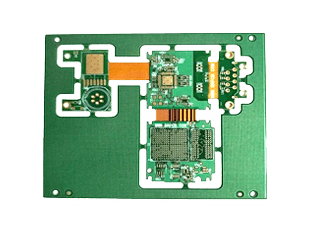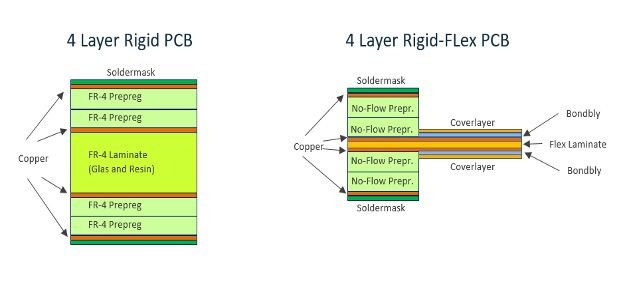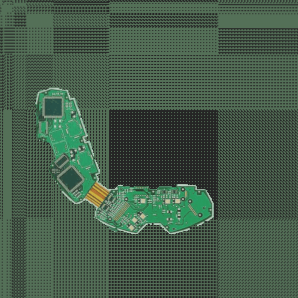WellCircuits is a technical flexible PCB manufacturer with expterise on Rigid-flex PCBs, once reserved for military and aerospace, now power diverse industries. Transitioning from manual to automated production, these boards offer miniaturization and reliability. Flexible polyimide films connect rigid sections, replacing cables and connectors in tight spaces.We specialize in optimized rigid-flex PCB design, combining RF PCB expertise with advanced manufacturing. Let us help you achieve precision and reliability for your next project.
Rigid-Flex PCB
- 3D design freedom.
- Dynamic possibilities.
- Reduce volume and weight.
- Reliable connection.
- Simplified assembly process.
- Reduce costs.


Rigid-Flex PCB Substrates
- Flexible copper-clad laminate.
- Coverlay.
- Non-flowing prepreg.
- Bond ply material.
- Rigid clad material.
RIGID-FLEX PCB Definition and Overview
Rigid-Flex PCBs merge the features of rigid and flexible printed circuit boards to provide dependable compact circuit designs. They allow the creation of intricate 3D designs and complex shapes in flex PCB applications which renders them perfect for use in smartphones and industrial and aerospace systems. The creation of these PCBs requires strict management of complex manufacturing rules and specialized materials to maintain flexibility and performance during both flex prototype and production phases.
Differences Between Rigid, Flex, and Rigid-Flex PCBs
Polyimide-based flexible PCBs provide essential adaptability for wearable technologies and offer special benefits in condensed circuit layouts. Rigid-Flex PCBs combine rigid boards with flexible segments to deliver both adaptability and strong support. The design of traditional rigid PCBs uses materials such as FR-4 which prevents bending while rigid-flex PCB manufacturing requires flexibility considerations. The integrated design approach and use of flexible materials during production and assembly make rigid-flex PCBs both complex and expensive.
Design Considerations for Rigid-Flex PCBs
Material Selection: Adhesives and Laminates
Modified epoxy film and polyimide laminates serve as essential bonding agents for circuit protection in flex circuits whereas rigid-flex components demand completely separate requirements. The choice of materials for rigid flex PCBs requires an evaluation of mechanical flexibility along with thermal and electrical performance characteristics to maintain design reliability over time.
Layer Configuration: PCB designs may come in single-sided, double-sided, and multi-layered configurations including flex layer options for rigid-flex designs.
Manufacturing rigid-flex PCBs involves creating single-sided, double-sided and multi-layered boards with stackup configurations that extend from four up to eighteen layers for both PCB fabrication and assembly. Multi-layered structures within rigid-flex printed circuit boards boost connectivity while increasing complexity to fulfill varying application demands during the design phase of rigid-flex PCBs.
Trace Width and Spacing decisions remain critical throughout the rigid-flex manufacturing phase.
Maintaining uniform trace width and spacing throughout the PCB design process helps achieve necessary impedance control and signal integrity for rigid-flex PCBs. Reliable performance in high-speed applications of rigid-flex circuit boards results from proper routing and design planning during the early stages of the rigid-flex design process.
Manufacturing Processes
Combining Rigid and Flexible Layers
The combination of rigid outer layers and flexible inner layers through copper-plated vias enables rigid-flex PCBs to offer advanced circuit board solutions. The design decreases dependency on connectors and wiring harnesses to enhance reliability and component density for large scale rigid-flex PCB applications, especially beneficial in the flex portion.
High-Precision Drilling Techniques
Advanced drilling techniques used in rigid-flex PCB production maintain precision tolerances of +/- 0.05 mm while enabling intricate mechanical designs that adhere to strict design rules from the beginning.
Quality Control Measures
Specialized handling processes, together with careful material selection and rigorous inspection,n ensure long-term performance and reliability in rigid-flex PCB production.
Applications of Rigid-Flex PCBs
Static vs Dynamic Applications
During installation static applications need flexibility but dynamic applications require ongoing flexing throughout operation as seen in flexible PCB implementations. ED copper serves static applications while RA copper works for dynamic applications to maintain durability during flex and rigid-flex PCB manufacturing so PCB portions excel in high-performance tasks.
Use in Consumer Electronics
Consumer electronics such as smartphones and wearables frequently use Rigid-Flex PCBs to demonstrate flexible circuit boards’ adaptable capabilities. These PCB solutions deliver durable and space-efficient designs by overcoming rigid PCB constraints while maintaining proper integration between rigid and flexible circuit board components.
Aerospace and Defense Applications
The superior flexibility and durability of Rigid-Flex PCBs enables them to endure extreme conditions making them the preferred option for aerospace and defense applications. The fabrication process of rigid-flex circuit boards meets rigorous industry reliability standards through essential design rule adherence and advanced flex technology deployment for large scale production needs.
Medical Devices Integration
Rigid-Flex PCBs demonstrate their critical role in flex and rigid-flex circuit boards applications through enhanced reliability and space reduction in medical devices such as pacemakers. Precise fabrication and flexibility enable miniaturization and high-density interconnects in flexible sections of flexible-rigid assemblies.
Innovations in Rigid-Flex PCB Technology
Advanced Material Innovations
Rigid-Flex PCBs incorporate rolled annealed copper foil as part of their advanced materials portfolio to deliver both high-density functionality and dynamic flexibility in their design. The development of rigid flex prototypes enables quality flex PCB fabrication with reduced part counts and performance improvements during early design stages.
Enhanced Manufacturing Equipment and Techniques
Long-term reliability and performance of rigid-flex PCB solutions are secured through the use of advanced manufacturing techniques like high-reliability materials and precision drilling.
Industry Trends and Future Developments
The market requirement for compact yet dependable devices leads to increased production of Rigid-Flex PCBs which extend their use into rigid board technology and support cutting-edge flexible circuit board designs. The use of multi-layer designs and selective connections in rigid-flex boards improves flexibility and strength and thus meets future electronic requirements for large-scale rigid-flex PCB manufacturing with strategic rigid-flex integration.
Benefits of Rigid-Flex PCBs
Mechanical Durability
Rigid-flex PCBs demonstrate superior resilience to mechanical stress and vibrations which allows them to function effectively in demanding PCB fabrication settings particularly when working with flexible and rigid-flex designs during both design and fabrication stages. The design lowers failure rates leading to extended product lifespans and dependable operation under harsh conditions which proves essential for rigid components in rigid printed circuit boards while mindful selection of rigid-flex solutions is applied.
Space and Weight Reduction
Rigid-flex PCBs combine rigid and flexible areas to remove connectors and cables and decrease the size and weight of flexible circuit applications. Rigid-flex PCBs serve as perfect solutions for compact and lightweight applications within flexible and rigid-flex technology fields during the initial design stages where flexibility is prioritized.
Reliable Performance
The high reliability of Rigid-Flex PCBs stems from minimized connectors and solder joints which makes them an excellent option for rigid-flex solutions in demanding applications during soldering than rigid FR4 boards. These materials survive many bending cycles while delivering dependable performance when exposed to tough environments.
Challenges in Manufacturing Rigid-Flex PCBs
Cost and Complexity
The production of rigid-flex PCBs requires specialized materials and processes which increase both cost and complexity especially when flex layers must be integrated. The production of rigid-flex PCBs cuts assembly expenses by decreasing both component numbers and manual procedures which still takes longer than producing rigid boards.
Design and Prototyping Difficulties
Creating rigid-flex printed circuit boards demands adherence to complex design rules as well as meticulous planning to fulfill both mechanical and electrical requirements in PCB design. The production of a rigid flex prototype needs careful consideration of material limitations and layer stacking configurations.



